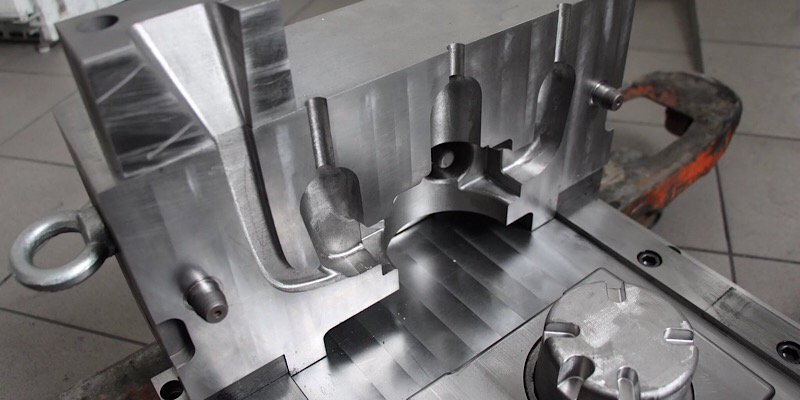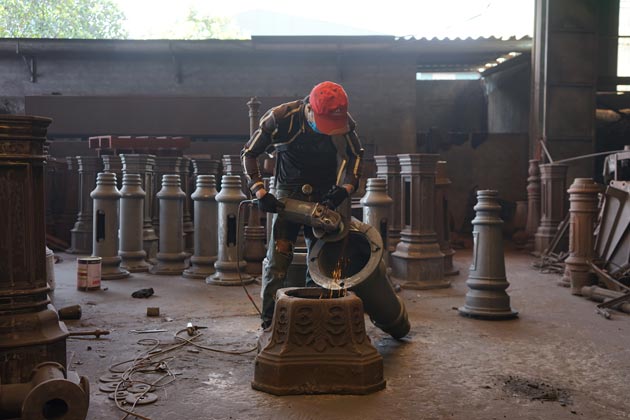Aluminum Foundry Wisconsin is a foundation of casting services
Exactly How Aluminum Foundry Adds to Advancements in Aerospace Design
Aluminum foundries are essential to improvements in aerospace design. They create lightweight, high-strength parts that are essential for modern airplane. With advanced casting methods, these shops produce intricate geometries that improve architectural stability. Furthermore, the growth of premium Aluminum alloys sustains the market's emphasis on fuel efficiency and sustainability. Nonetheless, difficulties remain in the manufacturing process. Recognizing these variables exposes the profound influence of Aluminum on aviation's future.
The Importance of Lightweight Products in Aerospace Style
As the aerospace sector remains to progress, the significance of light-weight materials ends up being significantly apparent. The need for efficiency and sustainability drives designers to prioritize using materials that minimize overall weight without endangering structural integrity. Light-weight products, particularly Aluminum, play a crucial function in enhancing gas efficiency, boosting haul capability, and raising the general efficiency of airplane.
The combination of these products permits for innovative styles, making it possible for manufacturers to create more wind resistant shapes that can endure severe conditions. The decrease in weight not just decreases operational costs but likewise adds to a reduced environmental impact, aligning with global initiatives towards sustainability in aeronautics.
Advanced Spreading Techniques in Aluminum Foundries
Advanced spreading methods in Aluminum shops play a vital role in aerospace engineering by making it possible for the production of lightweight and accurate parts. Technologies in mold style and precision casting processes are vital in accomplishing excellent performance and architectural stability. Additionally, the development of light-weight alloys boosts the general effectiveness and efficiency of aerospace applications.
Cutting-edge Mold And Mildew Design
Innovative mold design plays a vital function in the effectiveness and efficiency of Aluminum factories, specifically within the aerospace industry. By leveraging sophisticated products and strategies, contemporary mold and mildews can be crafted to hold up against heats and pressures, making sure peak efficiency throughout the spreading process. These styles typically include complex geometries that permit for the manufacturing of light-weight yet structurally sound parts, vital for aerospace applications. Furthermore, making use of computer-aided style (CAD) software facilitates specific modeling, making it possible for shops to replicate and refine mold layouts before physical production begins. This not just enhances the quality of actors parts but likewise reduces waste and lead times, bring about considerable expense financial savings. On the whole, cutting-edge mold layout is a keystone of progression in Aluminum Foundry innovation for aerospace design.
Accuracy Casting Processes
The efficiency of innovative mold and mildew designs flawlessly incorporates with precision casting processes, which are essential for generating premium Aluminum components in aerospace engineering. These procedures, including sand spreading, pass away spreading, and investment casting, assure the creation of intricate geometries with limited tolerances. Advanced techniques like vacuum spreading and pressure pass away casting improve the honesty and surface finish of the end products. Accuracy casting lessens material waste while maximizing the mechanical residential properties of Aluminum, critical for aerospace applications. In addition, employing real-time monitoring and advanced simulation tools throughout the casting process enables immediate modifications, causing boosted quality assurance. Jointly, these precision spreading procedures placement Aluminum shops at the leading edge of aerospace innovation, sustaining the sector's need for reliability and performance.
Light-weight Alloy Advancement
As aerospace designers look for to enhance gas effectiveness and performance, light-weight alloy development becomes a necessary focus in Aluminum foundries. These shops utilize sophisticated casting techniques to create alloys that provide superior strength-to-weight ratios. Developments in alloy structure, including the consolidation of components like lithium and magnesium, make it possible for the production of materials that hold up against extreme problems while reducing total aircraft weight. Strategies such as die spreading and financial investment casting facilitate the accuracy production of intricate shapes, which are essential for aerospace applications. Furthermore, continuous research intends to optimize these alloys for boosted mechanical buildings and raised longevity. By prioritizing lightweight alloy development, Aluminum shops considerably contribute to the development of aerospace design, paving the means for more efficient and lasting airplane designs.

Enhancing Structural Honesty Via Aluminum Components
Aluminum components provide considerable advantages in boosting structural honesty within aerospace design. Their lightweight nature adds to general performance while keeping toughness, which is necessary for airplane efficiency. In addition, the stress and anxiety resistance homes of Aluminum help guarantee the resilience and integrity of aerospace frameworks under different functional conditions.
Lightweight Product Benefits
While traditional materials commonly endanger weight for toughness, making use of Aluminum components in aerospace engineering offers substantial benefits in architectural honesty. Aluminum's lightweight nature adds to overall layout performance, permitting more streamlined aircraft that eat less gas, thereby enhancing sustainability. The product's outstanding strength-to-weight ratio guarantees that parts keep longevity without including unnecessary mass. This top quality promotes improved performance and dexterity in flight, in addition to optimized haul capabilities. Additionally, Aluminum's resistance to deterioration extends the lifespan of aerospace structures, reducing maintenance prices and improving safety. As suppliers significantly embrace Aluminum alloys, the aerospace sector experiences a transformative shift in the direction of a lot more reliable and efficient engineering solutions that prioritize both efficiency and ecological obligation.
Tension Resistance Features
Although different products possess special residential properties, Aluminum's extraordinary stress resistance sticks out as an essential consider enhancing the architectural integrity of aerospace parts. This resistance plays a vital duty in guaranteeing that airplane can hold up against various operational anxieties, consisting of fatigue, influence, and environmental conditions. Aluminum alloys, particularly crafted for aerospace applications, show high tensile toughness while maintaining lightweight qualities, allowing designers to design much more effective frameworks - Aluminum Foundry. Additionally, the ability of Aluminum to endure cyclic loading without significant deformation contributes to the longevity and reliability of aerospace elements. As innovations proceed in Aluminum Foundry techniques, the advancement of stress-resistant Aluminum find more information elements guarantees additional renovations in efficiency, safety and security, and performance throughout the aerospace market, strengthening Aluminum's duty as a preferred material in modern-day design
Fuel Performance Improvements Driven by Aluminum Innovations
As the aerospace market looks for to boost gas performance, cutting-edge uses Aluminum have actually become a crucial remedy. Aluminum's lightweight nature significantly decreases airplane weight, permitting reduced fuel consumption throughout trip. This decrease in weight is essential, as also tiny declines can cause considerable enhancements in total gas economic situation.
Advanced Aluminum alloys, made for enhanced strength and sturdiness, make it possible for makers to develop elements that preserve structural honesty while reducing mass - Aluminum Foundry. Additionally, the integration of Aluminum in airframes and engine components facilitates improved the rules of aerodynamics, adding to minimized drag and boosted effectiveness
The adoption of Aluminum in aerospace not only meets the need for fuel-efficient design but additionally straightens with regulatory stress for lower emissions. As these advancements remain to develop, they play a substantial duty in setting brand-new standards for click now gas performance, guaranteeing that the aerospace market can fulfill expanding economic and environmental obstacles.

The Function of Aluminum in Sustainable Aviation Practices
The raising emphasis on lasting aeronautics techniques has placed Aluminum as an important material in the pursuit for greener aircraft style. Understood for its light-weight homes, Aluminum significantly lowers airplane weight, leading to lower fuel intake and exhausts. Its recyclability additionally boosts its sustainability account, as Aluminum can be reused indefinitely without loss of high quality. This particular supports a round economic situation within the aviation industry, reducing waste and resource deficiency.
Advancements in Aluminum alloys have boosted their stamina and corrosion resistance, permitting for longer solution life and reduced maintenance demands. These innovations assist in the advancement of extra reliable aircraft frameworks, adding to general sustainability efforts. Furthermore, Aluminum's thermal conductivity plays an important duty in energy-efficient styles, boosting systems such as warmth exchangers. Collectively, these qualities highlight Aluminum's pivotal function ahead of time lasting aviation, straightening with global initiatives aimed at reducing the environmental influence of flight.
Challenges Dealt With by Aluminum Foundries in Aerospace Manufacturing
While Aluminum shops play a vital duty in aerospace manufacturing, they face considerable difficulties that can impact manufacturing efficiency and quality. One major obstacle is the stringent quality assurance requirements needed in the aerospace market. Any flaw can compromise safety and performance, demanding rigorous inspection processes that expand production timelines. Additionally, factories frequently compete with varying raw product costs, which can influence prices and profitability. The complexity of Aluminum alloys utilized in aerospace applications additional makes complex the production procedure, as precise formulations are important for accomplishing preferred mechanical properties. Skilled labor shortages hinder the ability to keep high-grade manufacturing degrees. Finally, environmental policies enforce restrictions on emissions and waste management, needing foundries to buy sustainable methods, which can be cost-prohibitive. These elements jointly create a landscape where Aluminum factories should continuously adjust to fulfill the developing demands of aerospace manufacturing while making sure safety and compliance.
Future Trends in Aluminum Applications for Aerospace Design
With innovations in technology and raising demands for performance, the future of Aluminum applications in aerospace design is poised for substantial improvement. The assimilation of innovative Aluminum alloys and composites is anticipated to improve strength-to-weight proportions, bring about even more fuel-efficient airplane layouts. In addition, developments in additive production techniques will certainly enable for the production of intricate Aluminum structures that were formerly impossible, enhancing efficiency and reducing waste.

Sustainable techniques will play an essential duty, discover here with an expanding emphasis on reusing Aluminum to lessen environmental effect. The aerospace industry is likely to accept smarter producing processes, such as automation and expert system, ensuring higher top quality and precision in Aluminum elements. Cooperations in between Aluminum factories and aerospace companies will certainly foster study and growth, paving the way for new applications that fulfill the rigid requirements of modern-day aerospace engineering. On the whole, the future looks assuring for Aluminum's role fit the skies
Frequently Asked Questions
What Are the Environmental Influences of Aluminum Production in Aerospace?
The environmental effects of Aluminum production in aerospace consist of considerable energy consumption, greenhouse gas emissions, and environment disturbance. In addition, mining procedures can bring about dirt deterioration and water contamination, increasing worries concerning sustainability and eco-friendly equilibrium.
Exactly How Does Aluminum Contrast to Various Other Materials in Aerospace Applications?
Aluminum supplies a special combination of light-weight homes, corrosion resistance, and cost-effectiveness contrasted to other products. Its high strength-to-weight ratio makes it particularly helpful for aerospace applications, enhancing gas effectiveness and general efficiency in airplane style.
What Certifications Do Aluminum Foundry Workers Demand for Aerospace Projects?
Aluminum Foundry workers call for specific training in metallurgy and casting strategies, together with understanding of aerospace industry requirements. Certifications in top quality control and safety methods are also important to assure compliance with rigorous aerospace project needs.
Are There Any Kind Of Security Worry About Making Use Of Aluminum in Aerospace Engineering?
Safety problems pertaining to Aluminum in aerospace engineering include sensitivity to rust, fatigue, and stress and anxiety cracks. Correct treatment and alloy choice are vital to minimize these risks, guaranteeing architectural honesty and total safety in aerospace applications.
How Does Aluminum Recycling Benefit the Aerospace Market?
Aluminum reusing greatly profits the aerospace sector by lowering material prices, lessening ecological influence, and saving energy. This sustainable method boosts the industry's efficiency while promoting making use of lightweight, high-performance elements in aircraft manufacturing.
Advanced casting methods in Aluminum shops play a crucial function in aerospace engineering by making it possible for the production of exact and lightweight parts. Innovative mold and mildew design plays a crucial duty in the performance and performance of Aluminum factories, especially within the aerospace industry. As aerospace engineers look for to improve fuel effectiveness and performance, lightweight alloy growth comes to be a crucial emphasis in Aluminum factories. Aluminum alloys, specifically crafted for aerospace applications, show high tensile stamina while preserving light-weight features, making it possible for engineers to create much more effective structures. Cooperations in between Aluminum shops and aerospace firms will certainly promote research and growth, leading the way for brand-new applications that satisfy the stringent needs of modern-day aerospace engineering.